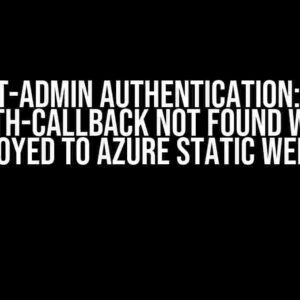Are you tired of manually creating and publishing NuGet packages for your .NET 2.0 standard library? Do you want to automate the process and make it more efficient? Look no further! In this article, we will guide you through the steps to package and push a .NET 2.0 standard library as a NuGet package in Azure DevOps build pipeline.
Why Automation Matters
Manual processes can be time-consuming and prone to errors. Automating the packaging and publishing of your NuGet package can save you time, reduce the risk of errors, and make your development workflow more efficient. With Azure DevOps, you can create a build pipeline that automates the entire process, from building and testing to packaging and publishing.
Prerequisites
Before we dive into the steps, make sure you have the following prerequisites:
- .NET 2.0 standard library project
- Azure DevOps account
- Azure DevOps project
- Azure Artifacts feed
- NuGet CLI installed on your machine
Step 1: Create a Build Pipeline
Log in to your Azure DevOps account and navigate to your project. Click on the Pipelines button and then click on New pipeline.
Select Empty job and click Next. Choose the .NET Core template and click Apply.
# .NET Core
pool:
vmImage: 'ubuntu-latest'
variables:
buildConfiguration: 'Release'
steps:
- task: DotNetCoreCLI@2
displayName: ' Restore NuGet packages'
inputs:
command: 'restore'
projects: '**/*.csproj'
In the above YAML script, we’re defining a build pipeline that uses the ubuntu-latest image and restores the NuGet packages for our .NET 2.0 standard library project.
Step 2: Build and Test the Project
Next, we need to build and test our project. Add the following steps to your pipeline:
- task: DotNetCoreCLI@2
displayName: 'Build the project'
inputs:
command: 'build'
projects: '**/*.csproj'
configuration: '$(buildConfiguration)'
- task: DotNetCoreCLI@2
displayName: 'Run unit tests'
inputs:
command: 'test'
projects: '**/*.csproj'
configuration: '$(buildConfiguration)'
In the above script, we’re building the project and running the unit tests using the DotNetCoreCLI task.
Step 3: Package the Library
Now, we need to package our .NET 2.0 standard library as a NuGet package. Add the following step to your pipeline:
- task: DotNetCoreCLI@2
displayName: 'Package the library'
inputs:
command: 'pack'
packagesToPack: '**/*.csproj'
packDestination: '$(System.ArtifactsDirectory)/packages'
nobuild: true
In the above script, we’re packaging the library using the DotNetCoreCLI task and specifying the output directory as $(System.ArtifactsDirectory)/packages.
Step 4: Push the Package to Azure Artifacts
Finally, we need to push the package to our Azure Artifacts feed. Add the following step to your pipeline:
- task: NuGetAuthenticate@0
displayName: 'Authenticate with Azure Artifacts'
inputs:
nuGetServiceConnections: 'Your Azure Artifacts Feed'
- task: NuGetCommand@2
displayName: 'Push the package'
inputs:
command: 'push'
packagesToPush: '$(System.ArtifactsDirectory)/packages/*.nupkg'
nuGetFeedType: 'internal'
publishVstsFeed: 'Your Azure Artifacts Feed'
In the above script, we’re authenticating with our Azure Artifacts feed using the NuGetAuthenticate task and then pushing the package to the feed using the NuGetCommand task.
Putting it all Together
Here’s the complete YAML script for the build pipeline:
# .NET Core
pool:
vmImage: 'ubuntu-latest'
variables:
buildConfiguration: 'Release'
steps:
- task: DotNetCoreCLI@2
displayName: ' Restore NuGet packages'
inputs:
command: 'restore'
projects: '**/*.csproj'
- task: DotNetCoreCLI@2
displayName: 'Build the project'
inputs:
command: 'build'
projects: '**/*.csproj'
configuration: '$(buildConfiguration)'
- task: DotNetCoreCLI@2
displayName: 'Run unit tests'
inputs:
command: 'test'
projects: '**/*.csproj'
configuration: '$(buildConfiguration)'
- task: DotNetCoreCLI@2
displayName: 'Package the library'
inputs:
command: 'pack'
packagesToPack: '**/*.csproj'
packDestination: '$(System.ArtifactsDirectory)/packages'
nobuild: true
- task: NuGetAuthenticate@0
displayName: 'Authenticate with Azure Artifacts'
inputs:
nuGetServiceConnections: 'Your Azure Artifacts Feed'
- task: NuGetCommand@2
displayName: 'Push the package'
inputs:
command: 'push'
packagesToPush: '$(System.ArtifactsDirectory)/packages/*.nupkg'
nuGetFeedType: 'internal'
publishVstsFeed: 'Your Azure Artifacts Feed'
Save and run the pipeline to package and push your .NET 2.0 standard library as a NuGet package to your Azure Artifacts feed.
Troubleshooting Common Issues
Here are some common issues you may encounter and their solutions:
| Issue | Solution |
|---|---|
| Error: Unable to find the package | Check that the package is correctly packaged and the path to the package is correct. |
| Error: Authentication failed | Check that your Azure Artifacts feed credentials are correct and you have the necessary permissions. |
| Error: Package already exists | Check that you’re using a unique version number for your package. You can use the `$(build.buildId)` variable to create a unique version number. |
Conclusion
In this article, we’ve shown you how to package and push a .NET 2.0 standard library as a NuGet package in Azure DevOps build pipeline. By following these steps, you can automate the packaging and publishing of your NuGet package and make your development workflow more efficient.
Remember to replace the placeholders with your own values and adjust the script according to your needs. Happy automating!
Frequently Asked Question
Get ready to package and push your .NET 2.0 standard library as a NuGet package in Azure DevOps build pipeline like a pro!
What are the prerequisites to package a .NET 2.0 standard library as a NuGet package?
To get started, you’ll need to have .NET 2.0 installed on your machine, along with the .NET CLI. Additionally, you’ll need to have your .NET 2.0 standard library project set up and ready to go. If you’re using Azure DevOps, you’ll also need to have a pipeline set up with the necessary tasks to build, package, and push your NuGet package.
How do I create a .nuspec file for my .NET 2.0 standard library?
To create a .nuspec file, you can use the `dotnet new` command in your terminal or command prompt. Simply navigate to your project directory and run `dotnet new nuget`. This will create a basic .nuspec file that you can customize to fit your needs. Alternatively, you can create the file manually and add the necessary metadata, such as the package name, version, and dependencies.
How do I package my .NET 2.0 standard library as a NuGet package using the .NET CLI?
To package your library, navigate to your project directory and run `dotnet pack`. This will create a NuGet package file (.nupkg) in your project directory. You can customize the packaging process by adding additional options, such as `-c Release` to specify the build configuration, or `-o
How do I push my NuGet package to a package feed in Azure DevOps?
In your Azure DevOps pipeline, you’ll need to add a `NuGetPush` task to push your package to a package feed. You’ll need to specify the package file, the feed URL, and the API key or credentials to authenticate with the feed. You can also customize the push process by adding additional options, such as `-SkipDuplicate` to skip pushing the package if it already exists in the feed.
How do I automate the packaging and pushing process in my Azure DevOps pipeline?
To automate the process, you can create a pipeline YAML file that defines the steps to build, package, and push your NuGet package. You can use the `DotNetCoreCLI@2` task to build and package your library, and the `NuGetPush` task to push the package to your feed. You can also add additional tasks, such as `DotNetCoreCLI@2` with the `restore` command to restore package dependencies, or `PublishBuildArtifacts` to publish the package file as a build artifact.


